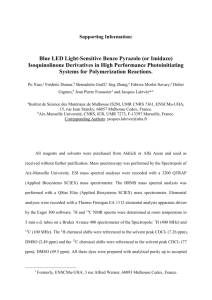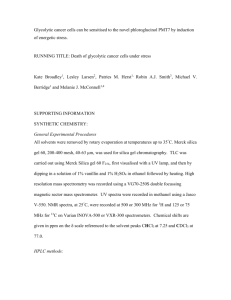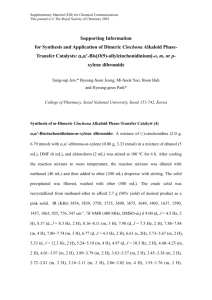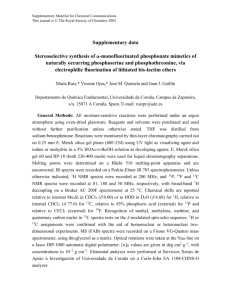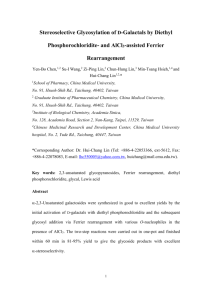Experimental - Royal Society of Chemistry
advertisement
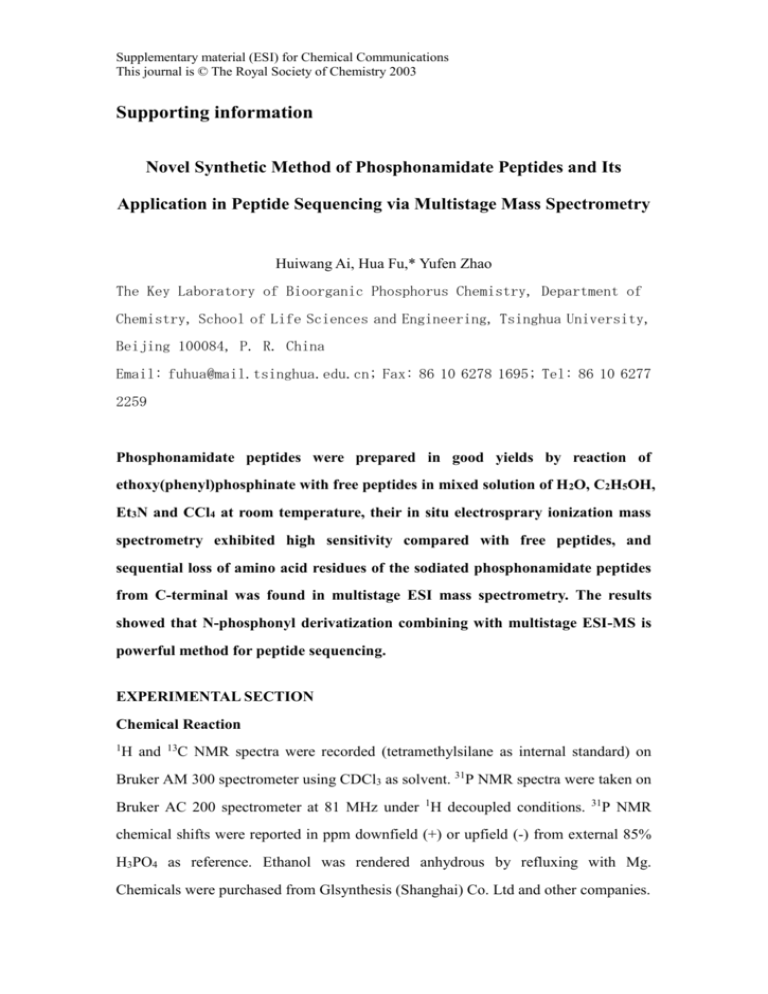
Supplementary material (ESI) for Chemical Communications This journal is © The Royal Society of Chemistry 2003 Supporting information Novel Synthetic Method of Phosphonamidate Peptides and Its Application in Peptide Sequencing via Multistage Mass Spectrometry Huiwang Ai, Hua Fu,* Yufen Zhao The Key Laboratory of Bioorganic Phosphorus Chemistry, Department of Chemistry, School of Life Sciences and Engineering, Tsinghua University, Beijing 100084, P. R. China Email: fuhua@mail.tsinghua.edu.cn; Fax: 86 10 6278 1695; Tel: 86 10 6277 2259 Phosphonamidate peptides were prepared in good yields by reaction of ethoxy(phenyl)phosphinate with free peptides in mixed solution of H 2O, C2H5OH, Et3N and CCl4 at room temperature, their in situ electrosprary ionization mass spectrometry exhibited high sensitivity compared with free peptides, and sequential loss of amino acid residues of the sodiated phosphonamidate peptides from C-terminal was found in multistage ESI mass spectrometry. The results showed that N-phosphonyl derivatization combining with multistage ESI-MS is powerful method for peptide sequencing. EXPERIMENTAL SECTION Chemical Reaction 1 H and 13 C NMR spectra were recorded (tetramethylsilane as internal standard) on Bruker AM 300 spectrometer using CDCl3 as solvent. 31P NMR spectra were taken on Bruker AC 200 spectrometer at 81 MHz under 1H decoupled conditions. 31 P NMR chemical shifts were reported in ppm downfield (+) or upfield (-) from external 85% H3PO4 as reference. Ethanol was rendered anhydrous by refluxing with Mg. Chemicals were purchased from Glsynthesis (Shanghai) Co. Ltd and other companies. Supplementary material (ESI) for Chemical Communications This journal is © The Royal Society of Chemistry 2003 Synthesis of ethoxyphenylphosphinate (EPP): 5mmol of ethanol was added dropwise to dichloro(phenyl)phosphine (DCPP) in 4mL of ethyl ether at room temperature under nitrogen atmosphere, the reaction completed within 30 min. The crude product EPP was obtained after distillation of gaseous HCl, ethyl ether and ethanol, and it can be used without further purification. General procedure for synthesis of phosphonamidate peptides: 1mmol of EPP in 1mL of CCl4 was added dropwise to 1mmol of Gly-Phe in mixed solution of water (1.5mL), ethanol (1mL) and triethylamine (0.5mL) at room temperature, the reaction was stirred for 30min. After isolation of silica gel column chromatography using chloroform: ethanol (20:1) as eluent, the corresponding phosphonamidate peptide was obtained as oil form, and it was identified by 31P, 1H, 13C NMR and ESI-MS. EPP-Gly-Phe: yield 65%; 31 P NMR (CDCl3, 81MHz, ppm) 24.39, 23.56; 1H NMR (CDCl3, 500MHz, ppm) 7.74-7.40 (m, 5H, P-Ph), 7.32-7.07(m, 5H, CH2Ph), 4.47 (d, 1H, CH (Phe)), 3.88-3.83 (m, 2H, OCH2CH3), 3.54-3.38 (m, 2H, CH2 (Gly)), 3.17-2.90 (m, 2H, CH2Ph), 1.26-1.17 (m, OCH2CH3); 13 C NMR (CDCl3, 125MHz, ppm) 176.5 (COOH), 170.7 (CONH), 137.6, 131.9, 131.3, 131.2, 129.1, 128.7, 128.3, 126.2 (CH2Ph, P-Ph), 61.1 (OCH2CH3), 55.5 (CH (Phe)), 43.6 (CH2 (Gly)), 37.4 (CH2Ph), 16.0 (OCH2CH3); ESIMS [M+Na]+ m/z 413. EPP-Gly-Gly: yield 68%; 31 P NMR (CDCl3, 81MHz, ppm) 25.68; 1H NMR (CDCl3, 500MHz, ppm) 7.75-7.35 (m, 5H, P-Ph), 4.01-3.51 (m, 4H, CH2COOH, OCH2CH3), 2.98-3.00 (m, 2H, CH2CONH), 1.10-1.18 (m, OCH2CH3); 13 C NMR (CDCl3, 125MHz, ppm) 174.1 (COOH), 171.0 (CONH), 131.9, 131.0, 130.9, 130.2, 128.0 (P-Ph), 61.1 (OCH2CH3), 43.1 (CH2COOH), 42.4 (CH2CONH), 15.24 (OCH2CH3); ESIMS [M+Na]+ m/z 323. Supplementary material (ESI) for Chemical Communications This journal is © The Royal Society of Chemistry 2003 O Cl Ph C2H5OH P Ph Cl P O H + NH 2CHC O O NHCHC R2 O Et3N/CCl4/H2O/C2H5OH P O NHCHC R Rn OC2H5 Ph (NHCHCO) n-3 HNCHC OC2H5 Rn (NHCHCO) n-3 R OH R1 O O NHCHC NHCHC R2 OH R1 Scheme S1. General Pathway of Phosphonylation of Peptides Mass spectrometrometry The mass spectra were obtained using a Bruker ESQUIRE LC ion trap spectrometry equipped with a gas nebulizer probe. Nitrogen was used as drying gas at a flow rate of 4 L/min. The nebulizer gas fore-pressure was 7 psi. The electrospray capillary was typically held at 4 kV. Samples were dissolved in methanol and ionized by electrospray ionization. The scan range was from m/z 50-700 in positive-ion. The selected ion [M + Na]+ was analyzed by multistage tandem mass spectrometry through collision with helium. Samples used in sequence analysis of peptides were prepared as follows. 1mg of peptide was dissolved in 200μL of deionized water, 100μL of triethylamine, 200μL of ethanol and 200μL of tetrachloromethane, and then 20μL of EPP was added to the solution. An excess of EPP (1.5-2 equiv) was used in order to completely phosphonylate peptide in a short time. The reaction mixture was stirred for 30 min, trace amount of NaCl was added to the solution (molar ratio of peptide and NaCl 1:1). The mixture was analyzed by ESI-MS/MS without any purification. Figure S1 In situ ESI-MS Spectrum of EPP-Gly-Phe Supplementary material (ESI) for Chemical Communications This journal is © The Royal Society of Chemistry 2003 Figure S2 ESI-MS2 of the precursor ion [M+Na]+ at m/z 413 for EPP-Gly-Phe Figure S3 ESI-MS3 of [M+Na-Phe]+ at m/z 266 for EPP-Gly-Phe Figure S4 ESI-MS2 of the precursor ion [M+Na]+ at m/z 422 for EPP-Ala-Ala-Ala Supplementary material (ESI) for Chemical Communications This journal is © The Royal Society of Chemistry 2003 Figure S5 ESI-MS3 of [M+Na-Ala]+ at m/z 351 for EPP-Ala-Ala-Ala Figure S6 ESI-MS4 of [M+Na-2Ala]+ at m/z 279 for EPP-Ala-Ala-Ala
